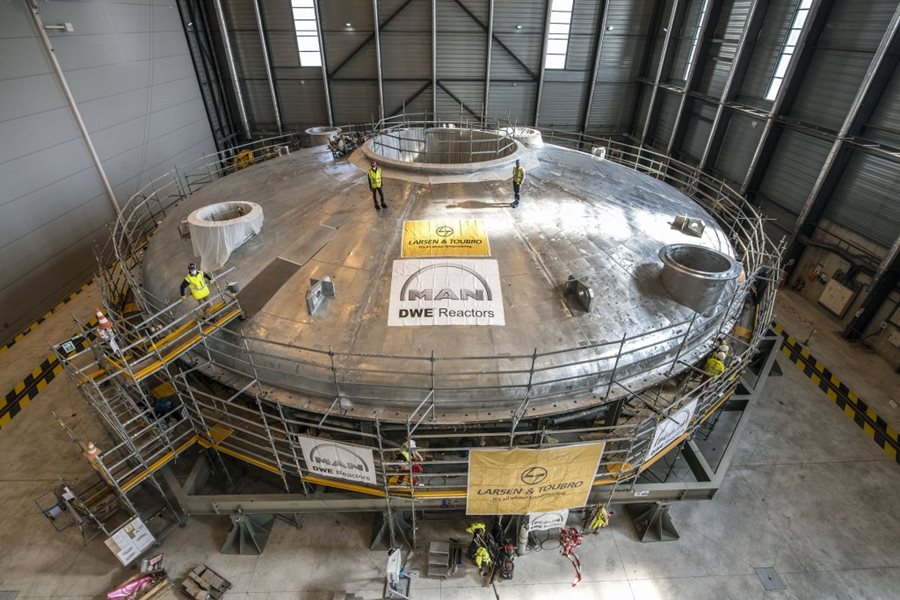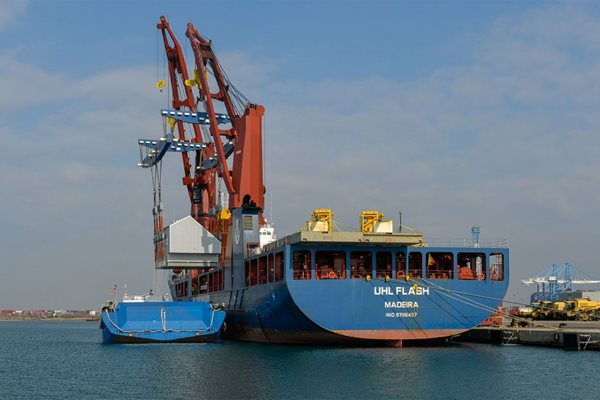
you're currently reading the news digest published from 07 Mar 2022 to 14 Mar 2022
featured2
of-interest1
video1
press9
featured
Cryostat top lid | Last checks before wrapping
On 10 December 2015, a convoy transporting three large steel pieces passed the gates of the ITER installation. Shaped like so many slices of pie, the 50-tonne, 60-degree 'segments' were the first elements of the ITER cryostat, the largest and most complex stainless steel high-vacuum chamber ever designed. Over the years that followed, a total of 54 major segments were delivered and progressively assembled to form the four sections of the giant steel cylinder: the base, lower cylinder, upper cylinder and top lid. The base and lower cylinder are now in place inside the Tokamak assembly pit, the upper cylinder is safely stored in its protective cocoon, and the top lid, now finalized, is being prepared for a long hibernation. Because it seals the cryostat, the 665-tonne circular structure will be the last machine component to be lowered into the assembly pit. 'Everything is in place, and within schedule. We just need to do some control and cleaning,' explains Guillaume Vitupier, who recently succeeded Anil Bhardwaj as Group Leader for the In-Cryostat, Cryostat Thermal Shield & Auxiliaries Section. In about a week the Indian Domestic Agency, responsible for the procurement, will hand the component over to the ITER Organization—a moment that will mark the conclusion of more than six years of intense work and collaboration between ITER India, cryostat manufacturer Larsen & Toubro Ltd, and the contractor for assembly and welding MAN Energy Solutions. Of the four sections that make up the ITER cryostat, the top lid is the thickest, second heaviest and most structurally complex. Contrary to the base and lower and upper cylinders, the top lid has a 3D profile, meaning that it is curved in three directions, a bit like a skull cap. 'As a consequence, the alignment of the 12 segments, although partially tested in India before shipment, was a very delicate operation here in the Cryostat Workshop,' says ITER cryostat engineer Girish Kumar Gupta. Metal contraction, due to the heat generated by the welding process, was another challenge. 'We had very good profile control throughout the operation, taking metrology measures every other day to monitor the behaviour of the component.' Just like the upper cylinder, finalized in the spring of 2019 and placed in a sealed cocoon outside the Cryostat Workshop, the top lid will also be 'mothballed' for protection. This time however, the shape of the component permits a different solution—as efficient but simpler, cheaper and more environmentally friendly. The cryostat top lid will be tightly wrapped in a sheet of material called VCI (volatile corrosion inhibitor) that ensures the long-term protection against humidity and other types of hazards. This solution was already employed for poloidal field coil #2, which was placed into storage in January. When the last of the cryostat sections is moved into storage in October 2022, the vast Cryostat Workshop will become available for other machine pre-assembly activities.
Image of the week | From ship to barge, directly
Shipped from industrial facilities located on three continents, the largest and heaviest ITER components are unloaded on dedicated heavy-load quays at Marseille industrial harbour Fos-sur-Mer. The operation consists in lifting the load from the depths of the ship's hold, sometimes rotating it in mid-air to align it with a transport trailer parked alongside the ship and eventually depositing it as carefully and as precisely as possible on the trailer's flat back. The trailer is then loaded on a specially designed barge and transported across the inland sea of Berre to start its land journey to the ITER site. Exceptionally, last week when vacuum vessel sector #8 arrived from Korea, no heavy-load quay was available at Fos and the load had to be transferred directly from the ship to the barge—a rather long and particularly delicate operation. On Wednesday 9 March, following two days of intense preparation supervised by ITER global logistics provider DAHER, smooth water and a lack of wind at Fos harbour created ideal conditions for the transfer. Barge and ship were placed alongside each other and, while electronic calculators adjusted ballast in real-time, the ship's massive on-board cranes slowly lifted the 558-tonne load. As ITER vacuum vessel sectors are placed perpendicular to the ship's hull in order to minimize the effects of acceleration during the sea voyage from Korea, the load had to be turned 90 degrees so that it could align with the barge. Once aligned, the load was lowered onto the barge deck and positioned on 16 stillage supports (also called 'stools' or 'elephant legs') under which the transport trailer was already in place. Small back and forth movements of the trailer allowed for the precise adjustment of the barge's centre of gravity. Loaded with the vacuum vessel sector in its cabin-like housing plus the 176-tonne trailer, the barge docked at Port de la Pointe on the north shore of the inland sea the following day. Road transportation to ITER is scheduled from 28 March to 1 April 2022. One final sector expected from Korea will be ready to sail in the first weeks of September. Five other sectors will be delivered to the ITER Organization by the European Domestic Agency.
of-interest
How to find the ITER podcast
"All About ITER," ITER's first podcast miniseries, is now available through World Radio Paris, the only 24/7 English-speaking national radio channel in France. If you haven't heard about it already, 'All About ITER' is a miniseries with six episodes that dive deep into what makes ITER tick: from the science behind fusion, to the manufacturing taking place all over the world, to the people behind the project. You can listen to "All About ITER" live on World Radio Paris (WRP) between the weeks of 7 March and 16 May (schedule below), on the WRP website, or by downloading the WRP app. And if you're not in France, the ITER podcast "All About ITER" is available on Apple Podcasts, Spotify, Google Podcasts, Amazon Music, Tune In, PodBean and the ITER website. Schedule: World Radio ParisMondays, 2 p.m.Tuesdays, 11 a.m.Fridays, 7 p.m.Episode 1: Week of 7 MarchEpisode 2: Week of 21 MarchEpisode 3: Week of 4 AprilEpisode 4: Week of 18 AprilEpisode 5: Week of 2 MayEpisode 6: Week of 16 May



